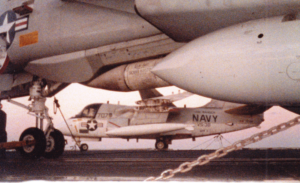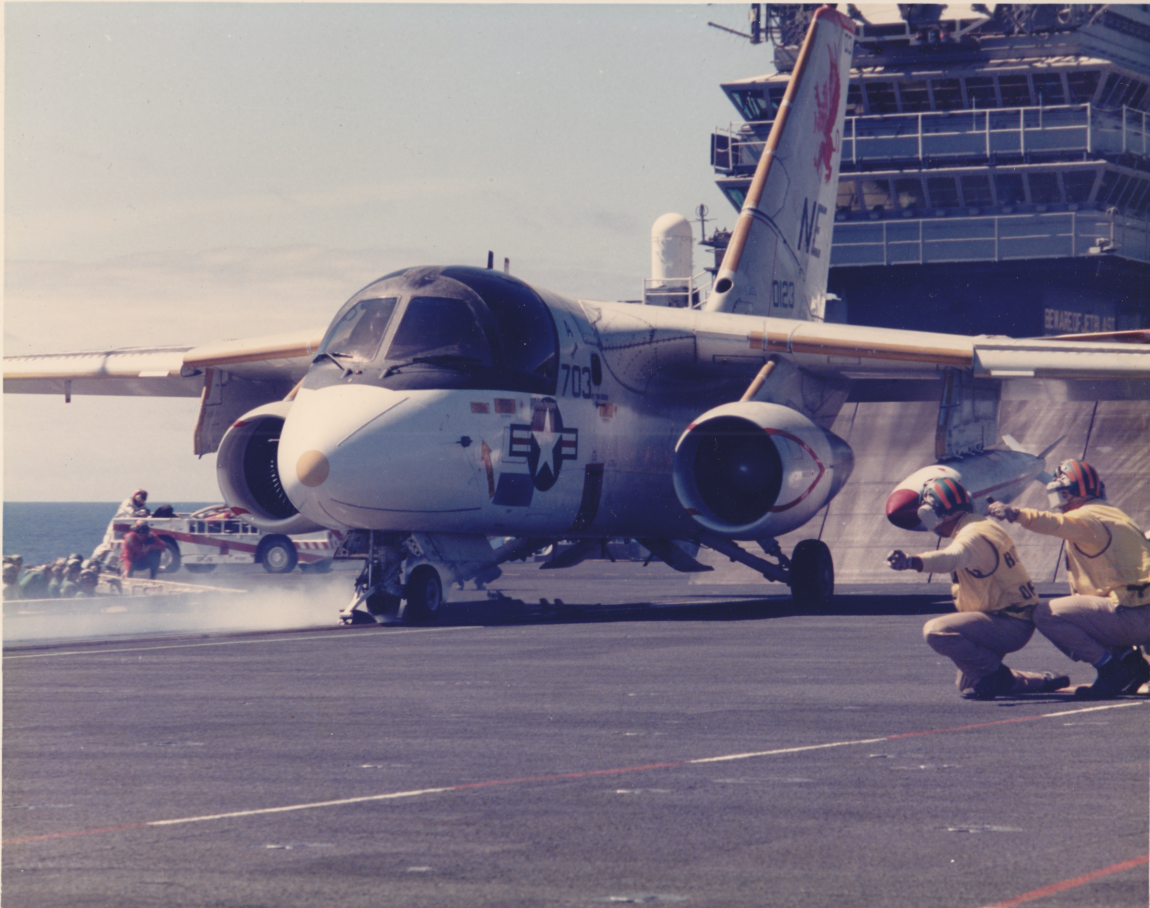“Thank you for your service”
I was privileged to have served in the U.S.Navy, fortunately during times of relative peace. I am humbly proud of having served, and though I appreciate it when others say “Thank you for your service,” I recognize that during my years on active duty and the reserves I never fired a shot nor was fired at in anger. Though some sacrifices were required, it was all in all “My pleasure” to serve. In fact, my volunteering to do something difficult did more for me than my ultimate value likely was for my country. Not so for most combat veterans, for whom “Thank you” is a start, but could never be enough.
S-3 Viking
My military rating was aviation electrician’s mate (AE). We AEs were known as “one-wires,” because it seemed that if a mechanical, hydraulic, avionics, or ordnance system in need of repair had even one wire attached, we were invariably called to help troubleshoot. I was trained to maintain the electrical systems of the Lockheed S-3 Viking, whose primary mission was then anti-submarine warfare (ASW). The S-3 was a four-seat carrier-based aircraft which featured an impressive avionics bay, a retractable magnetic anomaly detector (MAD boom), a launch bar, an arresting hook, and “fixed” wings that folded in half to allow it to be moved and stowed more easily on a crowded deck. In the two front seats sat a pilot and a co-pilot/tactical officer (COTAC), while the rear seats were designed for a tactical coordinator (TACCO) and a sensor operator (SENSO). When ASW tasks were not required. the rear seats could be used for passengers. I flew in the rear seat at least once, and felt a bit of jealousy for the SENSOs – enlisted guys like myself who weren’t always stuck on the ship but had the opportunity to fly regularly.
Carrier Duty

Red Griffin 703 on Cat 2
Even in peacetime, working on an aircraft carrier is extremely stimulating, to say the least. During operational down times, the flight deck with her full complement of eight Airwing squadrons aboard and 50-65 planes abovedecks is a scene of constant and colorful motion. The aircraft are continually re-positioned to and from the landing area and the forward and waist catapults in anticipation of the next planned operational sequence. It was and is critical to, “Keep your head on a swivel.” The actual launch and recovery operations were awe-inspiring. Picture jet engines from numerous taxiing aircraft blowing their exhaust in multiple directions, noise and steam obscuring hearing and sight-lines, wings folding and unfolding, tailhooks, launchbars, arresting gear, catapults, and jet blast deflectors in constant motion, and hundreds of crew scurrying this way and that to carry out their assigned responsibilities. Imagine this at night, and the scene seems even more unreal. Appropriately called the flight deck ballet,” operations aboard a forward deployed aircraft carrier are invariably high-tempo and high-stress.
Collateral Duties
 My collateral duties were many. I was a quality assurance inspector, a squadron safety representative, a special weapons loading team member, and a launch final-checker. This final duty entailed crouching near the wheel well of an aircraft with engines at full throttle moments before launch, visually inspecting key components, giving the “thumbs-up” to the launch officer, and holding on to the nearest tie-down pad-eye to avoid being bowled over by the exhaust of the departing jet. After launch I would stride through the steam and noise toward the next assignment. Every job since has rated somewhat lower on the excitement meter.
My collateral duties were many. I was a quality assurance inspector, a squadron safety representative, a special weapons loading team member, and a launch final-checker. This final duty entailed crouching near the wheel well of an aircraft with engines at full throttle moments before launch, visually inspecting key components, giving the “thumbs-up” to the launch officer, and holding on to the nearest tie-down pad-eye to avoid being bowled over by the exhaust of the departing jet. After launch I would stride through the steam and noise toward the next assignment. Every job since has rated somewhat lower on the excitement meter.
“Cheer up, Goombah”
As an aside, my annual reserve duty one summer was aboard a nuclear-powered aircraft carrier, larger and with more updated systems than my beloved diesel flattop. The launch officer was no longer on deck for example, but belowdecks under a protective glass canopy. I was there in a maintenance support role, and thus did not participate in the launches and recoveries. The two-week deployment was dragging and it must have showed in my face as I sat in the large chow hall. A voice behind me said, “Cheer up, Goombah, It’s not that bad.” There stood my old shipmate Mike Gamble, a SENSO from my active duty squadron whom I got to know well on the weapons loading team. The lead petty officer couldn’t pronounce “Guevara,” thus the nickname. “Goombah” became of term of endearment used only by a special few. Mike, then also in the reserves, was one of these select few and his presence on the ship really brightened my mood.
The Last Flight – Red Griffin 707

Red Griffin 707, tied down abovedecks
We were on a two-month deployment to the Western Pacific and the Sea of Japan. The S-3 Viking was equipped with a self-contained inertial navigation system (INS) that, as I understood it, was made up of gyroscopes and accelerometers and connected to a large onboard computer. With the INS the aircrew could track their orientation, velocity, and location from magnetic north, the ship, and fixed land masses. I used the system periodically to find out exactly where we were in the world, and how far we were from my home and family. There were times when it exceeded 9,000 miles, exciting and discouraging in equal measure. The ship had its own inertial navigation system (SINS), and it was somewhat important to link the two together before takeoff. This I did by attaching a SINS cable to a port on the S-3 fuselage. Red Griffin 707 was the first of three S-3s we were prepping for launch, and it had a known glitch we had been unable to repair. As soon as the engines were started and the power supply switched from auxiliary to internal, the aircraft INS dumped its settings. The cable was needed for another aircraft, so I disconnected it and ducked into the cockpit to tell the pilot what I was doing, barely noticing the rear crew members. While we talked I shut down the INS control panel. The pilot snapped at me, “What’d you do that for?” I replied in a somewhat flustered manner, “It was going to dump at engine start anyway.” The pilot growled, “Well maybe it wouldn’t have this time!” I turned toward the copilot who gave me a compassionate look. I don’t think we said anything, but it was a tender human moment. I mumbled my apologies. The pilot was right, of course, and I fretted about the exchange for a few hours. We launched our three aircraft and went on to other tasks. When we returned to the deck to meet our planes, only two had returned. Red Griffin 707 was unaccounted for.
What Happened?
All that evening the scuttlebutt flew. It seemed clear that our aircraft went down, but why? Was the aircrew able to escape? We had heard that there had never been a successful four-seat ejection from an S-3 up to that point in its history. Did our conversation before launch upset the pilot, and cause him to lose focus? The search and rescue helicopters returned many hours later. The TACCO and SENSO were rescued from the sea, both injured but alive. I believe the bodies of the pilot and COTAC were never recovered. Weeks later we heard second hand that the pilot was performing aerobatic maneuvers, and was having serious trouble. It was reported that the copilot was saying “We have to punch (eject). We have to punch,” with the pilot insisting, “No, I got it, I got it.” Only after precious time had elapsed did the pilot finally give the order to eject, just in time for the back-seaters but too late for the front.
I think about these men from time to time. When I utter a sarcastic, unwise, or harsh word, or make a joke that might be misunderstood it brings me back to that encounter in the cockpit. May our last word today and every day be kind and loving, and our last look filled with compassion and understanding.
Report from the Aviation Safety Network:
Date: 21-MAR-1987. Type: S-3A Viking. Owner: U.S. Navy. Registration: 160579. Fatalities:2/Occupants:4 Written off (damaged beyond repair).
Narrative: VS-38 a/c was photographing/rigging surface vessel when pilot lost control Pilot, LT V. Moezzi held up crew ejection. Back-seaters barely escaped, with Moezzi and LT F. Carozzo not surviving. Pilot may have caused mishap by initiating aerobatic maneuver on last rigging pass. Pilot’s body not recovered. Pilot – LT V. Moezzi, COTAC – LT F. Carozzo, TACCO – LT P. Hennes, SENSO AWC T. Gibson.





No Comments